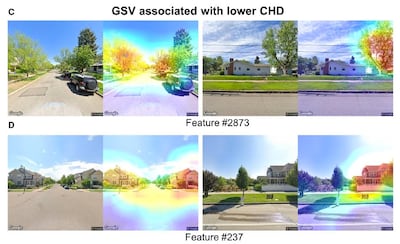Google Street View could be used to predict coronary heart disease risk by analysing neighbourhood environments, according to research.
A study, published in European Heart Journal, monitored everyday surroundings, including the quality of roads, buildings, and green spaces, and the role they play in determining heart health.
Researchers were able to track the link between these environmental elements, including the presence or absence of pollution, and the risk of coronary heart disease – a condition where the heart's arteries are blocked, limiting blood flow to the heart.
They found that these neighbourhood characteristics could account for 63 per cent of the differences in heart disease risk from one community to another.
The discovery stems from analysing more than half a million Google Street View images across US cities, using computer vision to identify and interpret details that might go unnoticed by the human eye.
The data provides urban planners and public health officials with information to design healthier living spaces and neighbourhoods.
“Undoubtedly, there is a vast amount of demographic, social, economic and environmental data set,” said one of the study's authors, Prof Sanjay Rajagopalan from Ohio's University Hospitals Harrington Heart and Vascular Institute and Case Western Reserve University.
“However, there still remain substantial gaps in our knowledge regarding unique environmental aspects of data that are currently beyond human perception or interpretation.
“This is where the use of computer vision approaches may enable unparalleled understanding of the physical and built environment.”
The study included images of Detroit, Michigan; Kansas City, Missouri; Cleveland, Ohio; Brownsville, Texas; Fremont, California; Bellevue, Washington State, and Denver, Colorado.
By employing artificial intelligence, researchers have been able to examine the minutiae of neighbourhoods' built environment.
The study employed computer vision technology, including applications used in medical imaging and autonomous driving, to identify details and then interpret them to make predictions or decisions, as they do when estimating disease risks or navigating vehicles safely.
“We are getting to a place in human civilisation where utilisation of artificial intelligence to enhance human understanding is going to be critically important at solving complex problems,” Prof Rajagopalan said.
“Traditional approaches that have been used are rather limited as they are dependent on human and often linear interpretation of existing and highly curated unidimensional data sets.”
Recent winners
2002 Giselle Khoury (Colombia)
2004 Nathalie Nasralla (France)
2005 Catherine Abboud (Oceania)
2007 Grace Bijjani (Mexico)
2008 Carina El-Keddissi (Brazil)
2009 Sara Mansour (Brazil)
2010 Daniella Rahme (Australia)
2011 Maria Farah (Canada)
2012 Cynthia Moukarzel (Kuwait)
2013 Layla Yarak (Australia)
2014 Lia Saad (UAE)
2015 Cynthia Farah (Australia)
2016 Yosmely Massaad (Venezuela)
2017 Dima Safi (Ivory Coast)
2018 Rachel Younan (Australia)
RESULTS
%3Cp%3E5pm%3A%20Wathba%20Stallions%20Cup%20%E2%80%93%20Handicap%20(PA)%20Dh70%2C000%20(Turf)%202%2C200m%3Cbr%3EWinner%3A%20RB%20Sarab%2C%20Allaia%20Tiar%20(jockey)%2C%20Khalifa%20Al%20Neyadi%20(trainer)%3C%2Fp%3E%0A%3Cp%3E5.30pm%3A%20Mamsha%20Alkhair%20%E2%80%93%20Handicap%20(PA)%20Dh80%2C000%20(T)%201%2C600m%3Cbr%3EWinner%3A%20Mutaqadim%2C%20Ray%20Dawson%2C%20Ibrahim%20Al%20Hadhrami%3C%2Fp%3E%0A%3Cp%3E6pm%3A%20Emirates%20Fillies%20Classic%20%E2%80%93%20Prestige%20(PA)%20Dh100%2C000%20(T)%201%2C600m%3Cbr%3EWinner%3A%20Almotajalliah%2C%20Ray%20Dawson%2C%20Ibrahim%20Al%20Hadhrami%3C%2Fp%3E%0A%3Cp%3E6.30pm%3A%20Emirates%20Colts%20Classic%20%E2%80%93%20Prestige%20(PA)%20Dh100%2C000%20(T)%201%2C600m%3Cbr%3EWinner%3A%20Fadwaan%2C%20Antonio%20Fresu%2C%20Ahmed%20Al%20Mehairbi%3C%2Fp%3E%0A%3Cp%3E7pm%3A%20The%20President%E2%80%99s%20Cup%20%E2%80%93%20Group%201%20(PA)%20Dh2%2C500%2C000%20(T)%202%2C200m%3Cbr%3EWinner%3A%20Mujeeb%2C%20Richard%20Mullen%2C%20Salem%20Al%20Ketbi%3C%2Fp%3E%0A%3Cp%3E7.30pm%3A%20The%20President%E2%80%99s%20Cup%20%E2%80%93%20Listed%20(TB)%20Dh380%2C000%20(T)%201%2C400m%3Cbr%3EWinner%3A%20Western%20Writer%2C%20Richard%20Mullen%2C%20Bhupat%20Seemar%3C%2Fp%3E%0A
The Details
Kabir Singh
Produced by: Cinestaan Studios, T-Series
Directed by: Sandeep Reddy Vanga
Starring: Shahid Kapoor, Kiara Advani, Suresh Oberoi, Soham Majumdar, Arjun Pahwa
Rating: 2.5/5
SERIES SCHEDULE
First Test, Galle International Stadium
July 26-30
Second Test, Sinhalese Sports Club Ground
August 3-7
Third Test, Pallekele International Stadium
August 12-16
First ODI, Rangiri Dambulla Stadium
August 20
Second ODI, Pallekele International Stadium
August 24
Third ODI, Pallekele International Stadium
August 27
Fourth ODI, R Premadasa Stadium
August 31
Fifth ODI, R Premadasa Stadium
September 3
T20, R Premadasa Stadium
September 6
KILLING OF QASSEM SULEIMANI
Teenage%20Mutant%20Ninja%20Turtles%3A%20Shredder's%20Revenge
%3Cp%3E%3Cstrong%3EDeveloper%3A%20%3C%2Fstrong%3ETribute%20Games%3Cbr%3E%3Cstrong%3EPublisher%3A%3C%2Fstrong%3E%20Dotemu%3Cbr%3E%3Cstrong%3EConsoles%3A%20%3C%2Fstrong%3ENintendo%20Switch%2C%20PlayStation%204%26amp%3B5%2C%20PC%20and%20Xbox%20One%3Cbr%3E%3Cstrong%3ERating%3A%3C%2Fstrong%3E%204%2F5%3C%2Fp%3E%0A
White hydrogen: Naturally occurring hydrogen
Chromite: Hard, metallic mineral containing iron oxide and chromium oxide
Ultramafic rocks: Dark-coloured rocks rich in magnesium or iron with very low silica content
Ophiolite: A section of the earth’s crust, which is oceanic in nature that has since been uplifted and exposed on land
Olivine: A commonly occurring magnesium iron silicate mineral that derives its name for its olive-green yellow-green colour
UAE currency: the story behind the money in your pockets
Profile
Company name: Marefa Digital
Based: Dubai Multi Commodities Centre
Number of employees: seven
Sector: e-learning
Funding stage: Pre-seed funding of Dh1.5m in 2017 and an initial seed round of Dh2m in 2019
Investors: Friends and family
Diriyah%20project%20at%20a%20glance
%3Cp%3E-%20Diriyah%E2%80%99s%201.9km%20King%20Salman%20Boulevard%2C%20a%20Parisian%20Champs-Elysees-inspired%20avenue%2C%20is%20scheduled%20for%20completion%20in%202028%0D%3Cbr%3E-%20The%20Royal%20Diriyah%20Opera%20House%20is%20expected%20to%20be%20completed%20in%20four%20years%0D%3Cbr%3E-%20Diriyah%E2%80%99s%20first%20of%2042%20hotels%2C%20the%20Bab%20Samhan%20hotel%2C%20will%20open%20in%20the%20first%20quarter%20of%202024%0D%3Cbr%3E-%20On%20completion%20in%202030%2C%20the%20Diriyah%20project%20is%20forecast%20to%20accommodate%20more%20than%20100%2C000%20people%0D%3Cbr%3E-%20The%20%2463.2%20billion%20Diriyah%20project%20will%20contribute%20%247.2%20billion%20to%20the%20kingdom%E2%80%99s%20GDP%0D%3Cbr%3E-%20It%20will%20create%20more%20than%20178%2C000%20jobs%20and%20aims%20to%20attract%20more%20than%2050%20million%20visits%20a%20year%0D%3Cbr%3E-%20About%202%2C000%20people%20work%20for%20the%20Diriyah%20Company%2C%20with%20more%20than%2086%20per%20cent%20being%20Saudi%20citizens%0D%3C%2Fp%3E%0A
Dengue%20fever%20symptoms
%3Cul%3E%0A%3Cli%3EHigh%20fever%3C%2Fli%3E%0A%3Cli%3EIntense%20pain%20behind%20your%20eyes%3C%2Fli%3E%0A%3Cli%3ESevere%20headache%3C%2Fli%3E%0A%3Cli%3EMuscle%20and%20joint%20pains%3C%2Fli%3E%0A%3Cli%3ENausea%3C%2Fli%3E%0A%3Cli%3EVomiting%3C%2Fli%3E%0A%3Cli%3ESwollen%20glands%3C%2Fli%3E%0A%3Cli%3ERash%3C%2Fli%3E%0A%3C%2Ful%3E%0A%3Cp%3EIf%20symptoms%20occur%2C%20they%20usually%20last%20for%20two-seven%20days%3C%2Fp%3E%0A
Liverpool's all-time goalscorers
Ian Rush 346
Roger Hunt 285
Mohamed Salah 250
Gordon Hodgson 241
Billy Liddell 228
Why it pays to compare
A comparison of sending Dh20,000 from the UAE using two different routes at the same time - the first direct from a UAE bank to a bank in Germany, and the second from the same UAE bank via an online platform to Germany - found key differences in cost and speed. The transfers were both initiated on January 30.
Route 1: bank transfer
The UAE bank charged Dh152.25 for the Dh20,000 transfer. On top of that, their exchange rate margin added a difference of around Dh415, compared with the mid-market rate.
Total cost: Dh567.25 - around 2.9 per cent of the total amount
Total received: €4,670.30
Route 2: online platform
The UAE bank’s charge for sending Dh20,000 to a UK dirham-denominated account was Dh2.10. The exchange rate margin cost was Dh60, plus a Dh12 fee.
Total cost: Dh74.10, around 0.4 per cent of the transaction
Total received: €4,756
The UAE bank transfer was far quicker – around two to three working days, while the online platform took around four to five days, but was considerably cheaper. In the online platform transfer, the funds were also exposed to currency risk during the period it took for them to arrive.
Benefits of first-time home buyers' scheme
- Priority access to new homes from participating developers
- Discounts on sales price of off-plan units
- Flexible payment plans from developers
- Mortgages with better interest rates, faster approval times and reduced fees
- DLD registration fee can be paid through banks or credit cards at zero interest rates
The specs
Engine: 2.0-litre 4-cylinder turbo
Power: 240hp at 5,500rpm
Torque: 390Nm at 3,000rpm
Transmission: eight-speed auto
Price: from Dh122,745
On sale: now
SHAITTAN
%3Cp%3E%3Cstrong%3EDirector%3A%20%3C%2Fstrong%3EVikas%20Bahl%3Cbr%3E%3Cstrong%3EStarring%3A%20%3C%2Fstrong%3EAjay%20Devgn%2C%20R.%20Madhavan%2C%20Jyothika%2C%20Janaki%20Bodiwala%3Cbr%3E%3Cstrong%3ERating%3A%20%3C%2Fstrong%3E3%2F5%3C%2Fp%3E%0A
BMW%20M4%20Competition
%3Cp%3E%3Cstrong%3EEngine%3A%20%3C%2Fstrong%3E3.0%20twin-turbo%20inline%20six-cylinder%0D%3Cbr%3E%3Cstrong%3ETransmission%3A%3C%2Fstrong%3E%20eight-speed%0D%3Cbr%3E%3Cstrong%3EPower%3A%20%3C%2Fstrong%3E503hp%0D%3Cbr%3E%3Cstrong%3ETorque%3A%3C%2Fstrong%3E%20600Nm%0D%3Cbr%3E%3Cstrong%3EPrice%3A%3C%2Fstrong%3E%20from%20Dh617%2C600%0D%3Cbr%3E%3Cstrong%3EOn%20sale%3A%3C%2Fstrong%3E%20Now%0D%3C%2Fp%3E%0A
Read more from Mina Al-Oraibi
A State of Passion
Directors: Carol Mansour and Muna Khalidi
Stars: Dr Ghassan Abu-Sittah
Rating: 4/5



